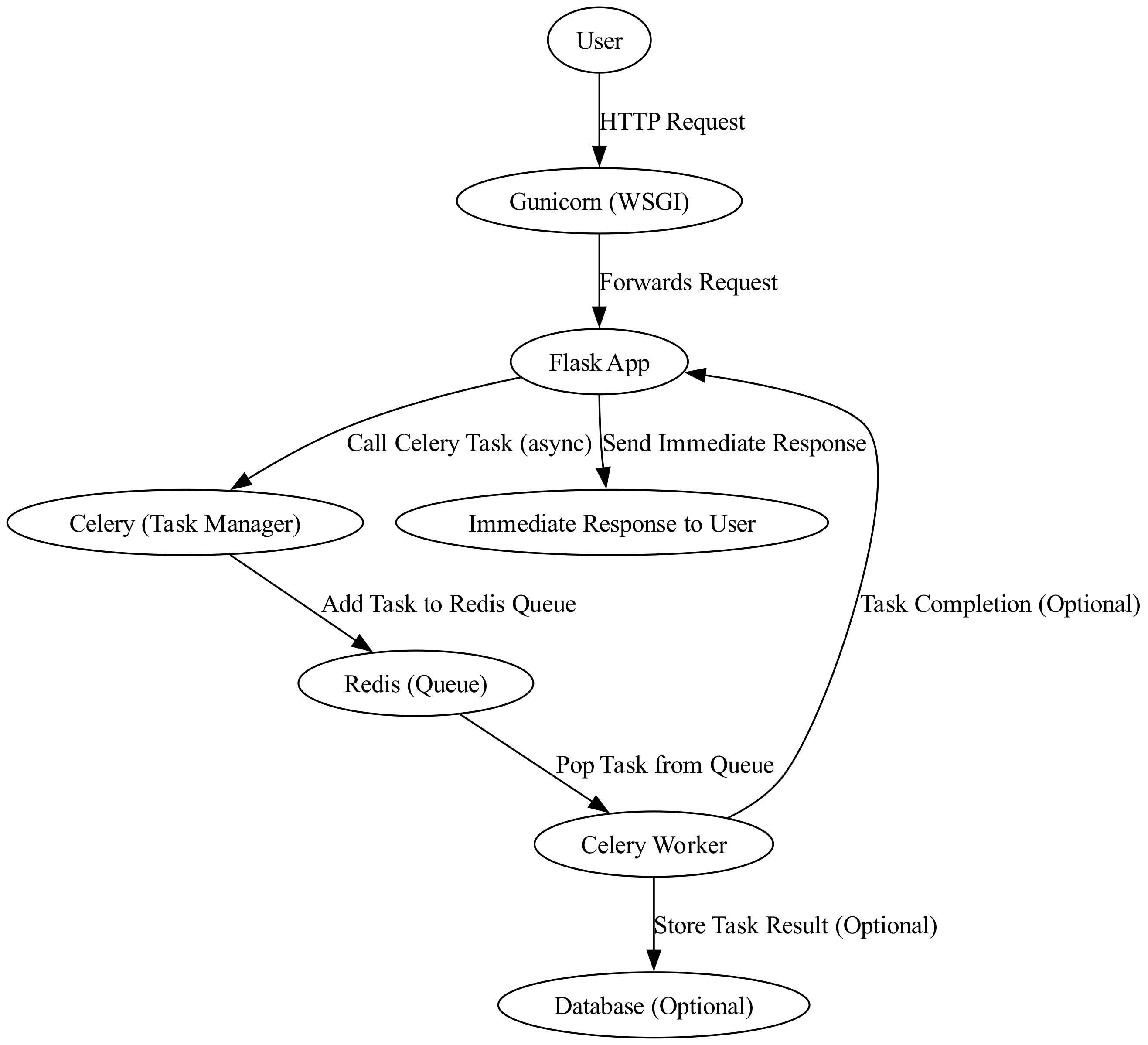Flask - Celery - Redis Boiler Plate
 Akshat Sharma
Akshat Sharma
Synchronous Tasks
Execution Flow:
Synchronous tasks are executed sequentially, meaning that the application will wait for a task to complete before moving on to the next one.
The main thread of the application is blocked while a synchronous task is running. For example, if a request handler is executing a synchronous task, it will not handle other requests until the current task completes.
Blocking:
- The application is blocked during the execution of the task. This can lead to performance issues if tasks are long-running or if there are many simultaneous tasks.
Use Case:
- Suitable for tasks that are quick and do not require waiting for external resources or services. It is also simpler to implement and understand.
Asynchronous Tasks
Execution Flow:
Asynchronous tasks are executed independently of the main execution flow. The application can continue to handle other requests while an asynchronous task is running.
Tasks are typically handled by background workers or threads, which do not block the main thread.
Non-Blocking:
- The application is not blocked by the execution of asynchronous tasks. This improves responsiveness and can handle a higher volume of concurrent tasks.
Use Case:
- Ideal for long-running tasks, I/O-bound operations, or tasks that involve waiting for external resources. It requires more complex implementation but can significantly improve performance and scalability.
What is Celery?
Celery is an asynchronous task queue/job queue used to execute tasks in the background. It allows you to offload time-consuming tasks (like sending emails, processing files, etc.) from the main application to background workers, improving the user experience and performance.
Purpose in Backend:
To offload long-running tasks to a background worker.
Handle tasks such as sending emails, image processing, or interacting with external APIs asynchronously.
What is Redis ?
Redis is an in-memory data structure store, primarily used as a database, cache, and message broker. In a Flask application, Redis typically acts as the message broker for Celery, but it can also be used for caching.
Purpose in backend:
Message Broker for Celery (to queue tasks and manage communication).
Caching data to improve performance by storing frequent queries or results in memory.
How Redis and Celery Work Together in a Flask App:

User Initiates Request:
- The process begins with a user making an HTTP request to the system.
Request Handling by Gunicorn:
- The request is received by Gunicorn, which is a WSGI server that handles HTTP requests.
Forwarding Request to Flask:
- Gunicorn forwards the HTTP request to the Flask application.
Flask Processes Request:
- The Flask application processes the request. If the request involves asynchronous tasks, Flask will call Celery.
Celery Manages Asynchronous Task:
- Flask sends an asynchronous task to Celery, which is responsible for managing background tasks.
Task Queued in Redis:
- Celery adds the task to the Redis queue. Redis serves as a message broker, queuing tasks for processing.
Worker Retrieves Task:
- Celery workers pull tasks from the Redis queue.
Worker (Optional):
- The worker may perform additional actions such as storing results in a database, if applicable.
Task Completion Notification (Optional):
- After completing the task, the worker may notify Flask (optional step depending on the architecture).
Immediate Response Sent to User:
- Regardless of the background task, Flask sends an immediate response back to the user.
Let’s Do a POC.
You can find the boilerplate here → https://github.com/AKXAT/Flask-Celery-Redis
Create the Following Directory Structure.
.
└── flask_celery_redis_flower
├── backend
│ ├── __init__.py
│ ├── tasks.py
│ └── views.py
├── celery_worker.sh
├── config.py
├── flower.sh
├── requirements.txt
└── run.py
First of all the
run.pyis responsible for starting the flask Application.the
config.pyhas the URLs for Redis Strored.import os # Flask configuration SECRET_KEY = os.getenv('SECRET_KEY', 'mysecret') # Redis and Celery configuration BROKER_URL = os.getenv('BROKER_URL', 'redis://localhost:6379/0') RESULT_BACKEND = os.getenv('RESULT_BACKEND', 'redis://localhost:6379/0')
flower.shstarts the Flower on local port.
What Flower Does:
Monitor Tasks:
- Flower provides an interface to track the status of tasks executed by Celery workers. You can see which tasks are pending, started, completed, or failed, along with their execution time and result.
Inspect Workers:
You can get detailed information about active workers such as:
Number of tasks they are processing.
Their current workload.
Worker uptime, state, and performance metrics.
Real-Time Monitoring:
- Flower allows you to monitor the Celery workers and tasks in real-time, making it easier to debug and optimize.
Task Events:
- View a history of task events like task retries, failures, and completion events.
Remote Control of Workers:
- Flower provides the ability to remotely control Celery workers through the web interface. You can pause/resume workers or revoke tasks.
celery_worker.shStarts Celery Worker.backend/__ini__.pyis Responsible for Importing Blue Prints and Initialising the Celery App.make_celeryFunction: This function is responsible for configuring and creating a Celery instance that is integrated with the Flask app.app.import_name: The name of the Flask app is passed to Celery to allow it to use the same module name.backend=app.config['RESULT_BACKEND']: This defines where task results are stored (in Redis, in this case). This enables Celery to store results after a task completes.broker=app.config['BROKER_URL']: The broker is the message queue (Redis in this case) that Celery uses to pass messages between the Flask app and the workers.celery.conf.update(app.config): Updates the Celery configuration with any settings defined in the Flask app's configuration (such as timeouts, result serialization, etc.).The function returns the fully configured Celery instance.
create_appFunction:app = Flask(__name__): This creates a new Flask application.Configuring Redis:
app.config['BROKER_URL']: Specifies Redis as the message broker (redis://127.0.0.1:6379/0, meaning Redis is running onlocalhost, port6379, and using the 0th database).app.config['RESULT_BACKEND']: Also specifies Redis to store the results of tasks (same Redis instance and database). You can either hardcode it here or readi it from the Config.pycelery = make_celery(app): Calls themake_celeryfunction to configure and initialize Celery with the Flask app’s settings.
Blueprint Registration:
The line
from .views import main as main_blueprintimports a Flask blueprint calledmainfrom theviewsmodule (this part isn't shown, but blueprints allow splitting a Flask app into reusable components).app.register_blueprint(main_blueprint): Registers the blueprint with the Flask app.
The function returns the Flask application instance, which will be used by the Flask server to handle requests.
Global Celery Instance:
This creates a global Celery instance that can be accessed from anywhere in the application.
It initializes Celery by calling
make_celery(create_app()), which creates a Flask app first and passes it intomake_celeryto create the Celery instance.
from flask import Flask from celery import Celery import os def make_celery(app): celery = Celery( app.import_name, backend=app.config['RESULT_BACKEND'], broker=app.config['BROKER_URL'] ) celery.conf.update(app.config) return celery def create_app(): app = Flask(__name__) # Set configuration for Redis app.config['BROKER_URL'] = 'redis://127.0.0.1:6379/0' app.config['RESULT_BACKEND'] = 'redis://127.0.0.1:6379/0' # Initialize Celery with the Flask app context celery = make_celery(app) # Register the blueprint from .views import main as main_blueprint app.register_blueprint(main_blueprint) return app # Create a Celery instance globally to be accessed from tasks celery = make_celery(create_app())
Route to Trigger the
long_task:/longtask@main.route('/longtask', methods=['GET']) def start_long_task(): task = long_task.apply_async() return jsonify({ 'task_id': task.id, 'status': 'Long task submitted!', }), 202
What This Route Does:
URL Endpoint:
/longtask(called using aGETrequest).Triggering a Task:
long_task.apply_async(): This is the key line that submits the task to Celery asynchronously.long_taskis a Celery task defined below, and.apply_async()is a method that sends the task to the Celery workers, allowing it to run in the background.Once the task is submitted, it does not block the Flask web server from continuing to serve other requests.
task.id: This is a unique ID that Celery generates for the task. This ID can be used later to track the task's progress or retrieve its result.
Response:
A JSON response is returned, which includes:
task_id: The unique task ID for tracking.status: A confirmation message that the task has been submitted.
The HTTP status code is
202, which means "Accepted"—the server has accepted the request, but it hasn't been completed yet (since the task will run in the background).
Example Celery Task:
long_task@current_app.task def long_task(): import time for i in range(300): print(f"Running step {i}...") time.sleep(10) # Simulate a time-consuming task return "Task complete!"What This Task Does:
Task Definition:
@current_app.task: This decorator registers thelong_taskfunction as a Celery task. Celery will recognize this as a function it can execute asynchronously when it's called (e.g., viaapply_async()).
Simulating a Long Task:
The task simulates a long-running process by iterating over a loop with 300 steps.
In each iteration, it:
Prints a message (
print(f"Running step {i}...")), which could appear in the logs.Sleeps for 10 seconds (
time.sleep(10)), simulating a time-consuming operation.
This means the entire task will take approximately 300 * 10 = 3000 seconds (or about 50 minutes) to complete.
Return Value:
- When the loop finishes, the task returns
"Task complete!". This result will be saved in Redis (the result backend), and it can be retrieved via the status check endpoint (/status/<task_id>).
- When the loop finishes, the task returns
Route to Check Task Status:
/status/<task_id>@main.route('/status/<task_id>', methods=['GET']) def task_status(task_id): task = long_task.AsyncResult(task_id) if task.state == 'PENDING': response = { 'state': task.state, 'status': 'Pending...', } elif task.state == 'SUCCESS': response = { 'state': task.state, 'result': task.result, } else: response = { 'state': task.state, 'status': str(task.info), # Can contain error messages or other info } return jsonify(response)What This Route Does:
URL Endpoint:
/status/<task_id>(called using aGETrequest). The<task_id>is a variable in the URL, which represents the unique ID of the task you want to check.Checking Task Status:
long_task.AsyncResult(task_id): This retrieves the task status and result for the giventask_id. Celery provides theAsyncResultobject, which holds the state and result of a task.
Task State Handling:
PENDING: If the task hasn't started yet or is waiting to be executed, it returns a response with the state"PENDING"and a message"Pending...".SUCCESS: If the task has successfully completed, it returns the state"SUCCESS"and the actual result (task.result), which will be the return value of the task.Other States: For any other states (e.g.,
STARTED,RETRY,FAILURE), it returns the current state and any additional information fromtask.info. This might include error messages if the task failed or any relevant progress information.
Response:
- A JSON response is returned with the task's current state and status or result, depending on what stage the task is in.
How To Test Locally.
Corrected Steps for Starting the Project Locally:
Clone the Project:
git clone https://github.com/AKXAT/Flask-Celery-Redis.gitNavigate to the Project Directory:
cd Flask-Celery-RedisCreate a Virtual Environment:
python -m venv venvActivate the Virtual Environment:
For Linux/macOS:
source venv/bin/activate
Install the Requirements:
pip install -r requirements.txtInstall and Start Redis Server:
If Redis is not installed on your system, install it first:
For macOS (using Homebrew):
brew install redisFor Ubuntu/Linux:
sudo apt-get install redis-server
Start Redis (if it's not already running):
redis-serverVerify Redis is Running: You can use the following command to test if Redis is working:
redis-cli pingIf it returns
PONG, Redis is up and running.
Run Celery Worker: Run the Celery worker to process background tasks.
If
celery_worker.shis provided in the project, run it:./celery_worker.sh
Run Flower (Optional for Monitoring): If you want to use Flower for real-time monitoring of Celery tasks:
If
flower.shis provided, run it:./flower.sh
Start the Flask Application: To run the Flask app, start it from
run.py:python run.pyTest the Endpoints: Now that everything is up and running, you can test the endpoints defined in your Flask app, such as:
Submitting a long task at
/longtask.Checking task status at
/status/<task_id>.
Thank you for reading!
I’m glad you made it to the end of this article. I hope you found the insights valuable. If you did, please consider leaving a like. Your support motivates me to continue writing and sharing more content in the future.
Connect with me on Linkedin
Start your own blogs
Subscribe to my newsletter
Read articles from Akshat Sharma directly inside your inbox. Subscribe to the newsletter, and don't miss out.
Written by

Akshat Sharma
Akshat Sharma
I am a Human who trys to learn new stuff every day.